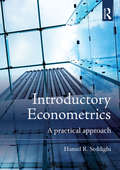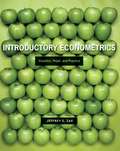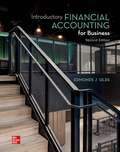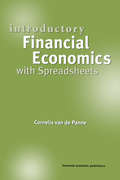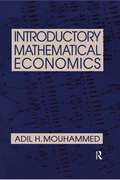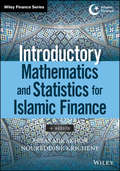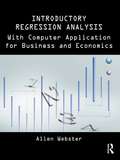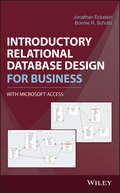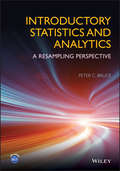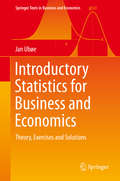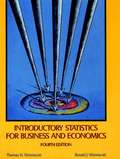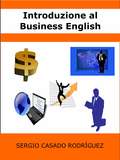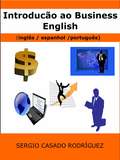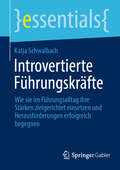- Table View
- List View
Introductory Econometrics: A Practical Approach
by Hamid SeddighiThis book constitutes the first serious attempt to explain the basics of econometrics and its applications in the clearest and simplest manner possible. Recognising the fact that a good level of mathematics is no longer a necessary prerequisite for economics/financial economics undergraduate and postgraduate programmes, it introduces this key subdivision of economics to an audience who might otherwise have been deterred by its complex nature.
Introductory Econometrics: Intuition, Proof, and Practice
by Jeffrey ZaxIntroductory Econometrics: Intuition, Proof, and Practice attempts to distill econometrics into a form that preserves its essence, but that is acceptable—and even appealing—to the student's intellectual palate. This book insists on rigor when it is essential, but it emphasizes intuition and seizes upon entertainment wherever possible. Introductory Econometrics is motivated by three beliefs. First, students are, perhaps despite themselves, interested in questions that only econometrics can answer. Second, through these answers, they can come to understand, appreciate, and even enjoy the enterprise of econometrics. Third, this text, which presents select innovations in presentation and practice, can provoke readers' interest and encourage the responsible and insightful application of econometric techniques. In particular, author Jeffrey S. Zax gives readers many opportunities to practice proofs—which are challenging, but which he has found to improve student comprehension. Learning from proofs gives readers an organic understanding of the message behind the numbers, a message that will benefit them as they come across statistics in their daily lives. An ideal core text for foundational econometrics courses, this book is appropriate for any student with a solid understanding of basic algebra—and a willingness to use that tool to investigate complicated issues.
Introductory Financial Accounting for Business
by Christopher T. Edmonds Mark A. Edmonds Jennifer E. EdmondsLearning Financial Accounting can often feel like learning a foreign language to students. Before students even grasp the underlying concepts of Accounting, they are immersed in unfamiliar terms, and before students fully realize the purpose of financial statements, they are asked to make detailed recording procedures. This early emphasis on terminology and recording can be a struggle for non-accounting majors to see the relevancy, leading to increased dropouts and higher failure rates. This creates a challenge for Financial Accounting instructors, who must balance the need to engage and retain non-majors while fully preparing Accounting majors for the next level. The authors of Introductory Financial Accounting for Business offer a solution emphasizing an analytical approach to Accounting – teaching students to think like business professionals and speak in terms of bottom-line consequences: How will a given transaction impact my overall business? How can I make better business decisions whether I’m an accountant, manager, or entrepreneur? Business leaders are demanding that new graduates have these critical thinking skills in order to handle a rapidly changing modern business environment. Today's students will encounter new technological advances in automated data capture, data analytics, and artificial intelligence – processes that are automating traditional recording procedures. Rather than tallying transactions, students will be required to analyze and interpret data, making decisions early and often and thinking like business professionals. The Edmonds/Olds team’s fresh approach and modern pedagogy helps prepare students for their business careers.
Introductory Financial Economics with Spreadsheets
by Cornelis van de PanneThis text combines the teaching and explanation of spreadsheets with the essentials of finance and economics in a highly-visual, interactive and project-based approach. Students progressively build skills in Microsoft Excel, by proceeding through a variety of basic applications. Users of other spreadsheets will also benefit from the book. This innovative publication includes an accompanying disk that provides the spreadsheet files on which the text is based and the data for the exercises and assignments following each chapter.
Introductory Mathematical Analysis for Business, Economics, and the Life and Social Sciences (Ninth Edition)
by Ernest F. Haeussler Richard S. PaulThis ninth edition of Introductory Mathematical Analysis continues to provide a mathematical foundation for students in business, economics, and the life and social sciences. It begins with noncalculus topics such as equations, functions, matrix algebra, linear programming, mathematics of finance, and probability. Then it progresses through both single-variable and multivariable calculus, including continuous random variables.
Introductory Mathematical Economics
by Adil H. MouhammedThis book provides both students and individuals with a simple and rigorous introduction to various mathematical techniques used in economic theory. It discusses the applications to macroeconomics and market models, and describes derivatives and their applications to economic theory.
Introductory Mathematics and Statistics for Islamic Finance
by Noureddine Krichene Abbas MirakhorA unique primer on quantitative methods as applied to Islamic financeIntroductory Mathematics and Statistics for Islamic Finance + Website is a comprehensive guide to quantitative methods, specifically as applied within the realm of Islamic finance. With applications based on research, the book provides readers with the working knowledge of math and statistics required to understand Islamic finance theory and practice. The numerous worked examples give students with various backgrounds a uniform set of common tools for studying Islamic finance.The in-depth study of finance requires a strong foundation in quantitative methods. Without a good grasp of math, probability, and statistics, published theoretical and applied works in Islamic finance remain out of reach. Unlike a typical math text, this book guides students through only the methods that directly apply to Islamic finance, without wasting time on irrelevant techniques. Each chapter contains a detailed explanation of the topic at hand, followed by an example based on real situations encountered in Islamic finance. Topics include:Algebra and matricesCalculus and differential equationsProbability theoryStatisticsWritten by leading experts on the subject, the book serves as a useful primer on the analysis methods and techniques students will encounter in published research, as well as day-to-day operations in finance. Anyone aspiring to be successful in Islamic finance needs these skills, and Introductory Mathematics and Statistics for Islamic Finance + Website is a clear, concise, and highly relevant guide.
Introductory Regression Analysis: with Computer Application for Business and Economics
by Allen WebsterRegression analysis is arguably the single most powerful and widely applicable tool in any effective examination of common business issues. Every day, decision-makers face problems that require constructive actions with significant consequences, and regression procedures can prove a meaningful and valuable asset in the decision-making process. This text is designed to help students achieve a full understanding of regression and the many ways it can be used. Taking into consideration current statistical technology, Introductory Regression Analysis focuses on the use and interpretation of software, while also demonstrating the logic, reasoning, and calculations that lie behind any statistical analysis. Furthermore, the text emphasizes the application of regression tools to real-life business concerns. This multilayered, yet pragmatic approach fully equips students to derive the benefit and meaning of a regression analysis. This text is designed to serve in a second undergraduate course in statistics, focusing on regression and its component features. The material presented in this text will build from a foundation of the principles of data analysis. Although previous exposure to statistical concepts would prove helpful, all the material needed for an examination of regression analysis is presented here in a clear and complete form.
Introductory Relational Database Design for Business, with Microsoft Access
by Jonathan Eckstein Bonnie R. SchultzA hands-on beginner’s guide to designing relational databases and managing data using Microsoft Access Relational databases represent one of the most enduring and pervasive forms of information technology. Yet most texts covering relational database design assume an extensive, sophisticated computer science background. There are texts on relational database software tools like Microsoft Access that assume less background, but they focus primarily on details of the user interface, with inadequate coverage of the underlying design issues of how to structure databases. Growing out of Professor Jonathan Eckstein’s twenty years’ experience teaching courses on management information systems (MIS) at Rutgers Business School, this book fills this gap in the literature by providing a rigorous introduction to relational databases for readers without prior computer science or programming experience. Relational Database Design for Business, with Microsoft Access helps readers to quickly develop a thorough, practical understanding of relational database design. It takes a step-by-step, real-world approach, using application examples from business and finance every step the way. As a result, readers learn to think concretely about database design and how to address issues that commonly arise when developing and manipulating relational databases. By the time they finish the final chapter, students will have the knowledge and skills needed to build relational databases with dozens of tables. They will also be able to build complete Microsoft Access applications around such databases. This text: Takes a hands-on approach using numerous real-world examples drawn from the worlds of business, finance, and more Gets readers up and running, fast, with the skills they need to use and develop relational databases with Microsoft Access Moves swiftly from conceptual fundamentals to advanced design techniques Leads readers step-by-step through data management and design, relational database theory, multiple tables and the possible relationships between them, Microsoft Access features such as forms and navigation, formulating queries in SQL, and normalization Introductory Relational Database Design for Business, with Microsoft Access is the definitive guide for undergraduate and graduate students in business, finance, and data analysis without prior experience in database design. While Microsoft Access is its primary “hands-on” learning vehicle, most of the skills in this text are transferrable to other relational database software such as MySQL.
Introductory Statistics and Analytics: A Resampling Perspective
by Peter C. BruceConcise, thoroughly class-tested primer that features basic statistical concepts in the concepts in the context of analytics, resampling, and the bootstrapA uniquely developed presentation of key statistical topics, Introductory Statistics and Analytics: A Resampling Perspective provides an accessible approach to statistical analytics, resampling, and the bootstrap for readers with various levels of exposure to basic probability and statistics. Originally class-tested at one of the first online learning companies in the discipline, www.statistics.com, the book primarily focuses on applications of statistical concepts developed via resampling, with a background discussion of mathematical theory. This feature stresses statistical literacy and understanding, which demonstrates the fundamental basis for statistical inference and demystifies traditional formulas. The book begins with illustrations that have the essential statistical topics interwoven throughout before moving on to demonstrate the proper design of studies. Meeting all of the Guidelines for Assessment and Instruction in Statistics Education (GAISE) requirements for an introductory statistics course, Introductory Statistics and Analytics: A Resampling Perspective also includes:Over 300 "Try It Yourself" exercises and intermittent practice questions, which challenge readers at multiple levels to investigate and explore key statistical conceptsNumerous interactive links designed to provide solutions to exercises and further information on crucial conceptsLinkages that connect statistics to the rapidly growing field of data scienceMultiple discussions of various software systems, such as Microsoft Office Excel®, StatCrunch, and R, to develop and analyze dataAreas of concern and/or contrasting points-of-view indicated through the use of "Caution" iconsIntroductory Statistics and Analytics: A Resampling Perspective is an excellent primary textbook for courses in preliminary statistics as well as a supplement for courses in upper-level statistics and related fields, such as biostatistics and econometrics. The book is also a general reference for readers interested in revisiting the value of statistics.
Introductory Statistics for Business and Economics
by Jan UbøeThis textbook discusses central statistical concepts and their use in business and economics. To endure the hardship of abstract statistical thinking, business and economics students need to see interesting applications at an early stage. Accordingly, the book predominantly focuses on exercises, several of which draw on simple applications of non-linear theory. The main body presents central ideas in a simple, straightforward manner; the exposition is concise, without sacrificing rigor. The book bridges the gap between theory and applications, with most exercises formulated in an economic context. Its simplicity of style makes the book suitable for students at any level, and every chapter starts out with simple problems. Several exercises, however, are more challenging, as they are devoted to the discussion of non-trivial economic problems where statistics plays a central part.
Introductory Statistics for Business and Economics (Fourth Edition)
by Ronald J. Wonnacott Thomas H. WonnacottThis Fourth Edition includes new sections on graphs, robust estimation, expected value and the bootstrap, in addition to new material on the use of computers. The regression model is well covered, including both nonlinear and multiple regression. The chapters contain many real-life examples and are relatively self-contained, making adaptable to a variety of courses.
Introduzione al Business English
by Sergio Casado Rodríguez Federico CasablancaEbook orientato a tutte quelle persone interessate a perfezionare il proprio inglese e introdursi i una delle sue varianti imprescindibili, l'inglese aziendale o Business English.
Introdução ao Business English (inglês/ espanhol / português)
by Sergio Casado Rodríguez Lourdes Vanessa BerthoudE-book trilingue (inglês/espanhol/português) orientado para todas as pessoas interessadas em aperfeiçoar seu inglês e se iniciar em uma de suas variantes mais imprescindíveis: o inglês para os negócios ou Business English.
Introvertierte Führungskräfte: Wie sie im Führungsalltag ihre Stärken zielgerichtet einsetzen und Herausforderungen erfolgreich begegnen (essentials)
by Katja SchwalbachIntrovertiert zu sein und gleichzeitig eine Führungsposition zu bekleiden, wird oft als unvereinbar angesehen - sowohl von leistungsstarken Introvertierten als auch von Personalverantwortlichen. Dieses essential widerlegt dieses Vorurteil und macht Introvertierten Mut, Führung zu übernehmen. Denn gerade Introvertierte bringen Stärken mit, die sie in der Führung von Mitarbeitenden optimal für eine herausragende Teamleistung nutzen können. Natürlich gibt es im Führungsalltag auch Herausforderungen, die insbesondere das Energiemanagement betreffen. Die Autorin stellt anhand ausführlicher Beispiele mögliche Strategien für herausfordernde Situationen vor und hilft damit Introvertierten, Schwierigkeiten im Arbeitsalltag schneller zu erkennen und eine persönliche Strategie zu entwickeln.
Introvision bei Stress- und Angstbewältigung: Kurz-Manual für Psychotherapeuten, Coaches und Berater (essentials)
by Melanie Neumann Kathrin HeckMelanie Neumann und Kathrin Heck präsentieren die vielfältigen Möglichkeiten, die die verhaltenstherapeutisch orientierte Methode der Introvision Praktikern aus den Bereichen Psychotherapie, Coaching und Beratung bietet. Das essential vermittelt anschaulich, wie die Introvision bei stress- und angstassoziierten Erkrankungen angewendet werden kann, und zeigt, dass es sich dabei um eine wirksame Therapiemethode handelt, die problemlos mit anderen psychotherapeutischen Verfahren kombiniert werden kann. Zahlreiche Fallbeispiele, Arbeitsbausteine und Anleitungen ermöglichen eine einfache Umsetzung der Introvision in die Praxis.
Intuit
by Frank V. CespedesThis case study provides an overview of Intuit's growth and, in particular, the sales and service initiatives that historically fueled the company's growth from start-up to a corporation. It also outlines certain processes and cultural values, as well as specific employee and leadership behaviors, that provided the foundation for those initiatives.
Intuit Inc.: Project AgriNova
by Tanya Bijlani Thomas R. EisenmannIn late 2008, a team from Intuit's office in Bangalore, India is evaluating an opportunity to launch a new venture that would use SMS to deliver crop price information to farmers in India.The case describes the structure of Indian agriculture and the problems experienced by farmers, who were often exploited by middlemen who entered into obtuse private arrangements with wholesale buyers. After five weeks of research, the team concludes that the opportunity warrants further exploration. The question is, what should they do next?
Intuit QuickBooks: From Product to Platform
by Elizabeth J. Altman Andrei HagiuThis case focuses on the challenges and opportunities faced by a successful incumbent organization attempting to transform a large portion of its business from a traditionally product-centric operating mode to a platform-based one that leverages network effects to create durable competitive advantage. Strategic questions include the extent to which the organization should invest in platform initiatives, the appropriate resource allocation among various product and platform offerings, and the most beneficial business model for each of a few candidate multi-sided platform initiatives.
Intuit's New CEO: Steve Bennett
by William A. Sahlman Alison Berkley WagonfeldDescribes the transition to a new CEO at Intuit, a successful software and financial services firm in California. The new CEO must decide what to change and how fast. He must also navigate within a culture everyone believes to be successful but he envisions can be improved.
Intuit, Inc.: Transforming an Entrepreneurial Company into a Collaborative Organization (A)
by Morten T. Hansen Christina DarwallDescribes how Intuit, Inc.'s CEO, Steve Bennett, changes the company from an entrepreneurial "siloed" organization into a collaborative one.
Intuit, Inc.: Transforming an Entrepreneurial Company into a Collaborative Organization (B)
by Morten T. Hansen Christina DarwallSupplements the (A) case.
Intuit: QuickBooks (B)
by David B. Yoffie Nicole Tempest KellerThis short case updates the earlier Intuit case on transitioning from a product company into a platform company. In addition to provided information on the recent successes and challenges of the business, it also explores a new challenge of building a platform with a branded third party solution or a "white label" solution, which would hide the third party brand.
Intuit: QuickBooks (B)
by David B. Yoffie Nicole Tempest KellerThis short case updates the earlier Intuit case on transitioning from a product company into a platform company. In addition to provided information on the recent successes and challenges of the business, it also explores a new challenge of building a platform with a branded third party solution or a "white label" solution, which would hide the third party brand.
Intuit: Turbo Tax PersonalPro - A Tale of Two Entrepreneurs
by Michael Roberts Joseph Fuller Shikhar GhoshThe case tells the story of a product manager within Intuit who develops an idea for a new product that spans two of the company's existing business units-professional tax software, sold to accountants, and the consumer focused TurboTax product. The new product -TurboTax Personal Pro-connects consumers with professional accountants online, allowing them to have their taxes prepared by a professional. The cycle of product development transpires within the larger, corporate context of Intuit, where founder Scott Cook has been attempting to transform the enterprise into a leaner, more innovative company. The case describes in detail the lean startup methods used by the new product team, and how their attempts bump up against the existing, entrenched systems and processes of the larger enterprise.
